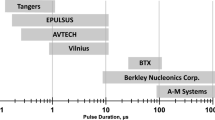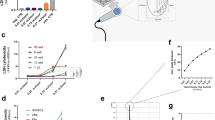Abstract
Microwave (MW) energy consists of electric and magnetic fields and is able to penetrate deep into biological materials. We investigated the effect of MW (2450 MHz) irradiation on gene delivery in cultured mouse myoblasts and observed enhanced transgene expression. This effect is, however, highly variable and critically dependent on the power levels, duration and cycle conditions of MW exposure. MW irradiation greatly enhances delivery of 2′O methyl-phosphorothioate antisense oligonucleotide (AON) targeting mouse dystrophin exon 23 and induces specific exon skipping in cultured myoblasts. Effective delivery of AON by MW irradiation is able to correct the dystrophin reading frame disrupted by a nonsense point mutation in the H2K mdx myoblasts, resulting in the restoration of dystrophin expression. MW-mediated nucleic acid delivery does not directly link to the increase in system temperature. The high variability in gene and oligonucleotide delivery is most likely the result of considerable irregularity in the distribution of the energy and magnetic field produced by MW with the current device. Therefore, achieving effective delivery of the therapeutic molecules would require new designs of MW devices capable of providing controllable and evenly distributed energy for homogenous exposure of the target cells.
This is a preview of subscription content, access via your institution
Access options
Subscribe to this journal
Receive 12 print issues and online access
$259.00 per year
only $21.58 per issue
Buy this article
- Purchase on Springer Link
- Instant access to full article PDF
Prices may be subject to local taxes which are calculated during checkout





Similar content being viewed by others
References
Gregorevic P, Blankinship MJ, Allen JM, Crawford RW, Meuse L, Miller DG et al. Systemic delivery of genes to striated muscles using adeno-associated viral vectors. Nat Med 2004; 10: 828–834.
Lu QL, Bou-Gharios G, Partridge TA . Non-viral gene delivery in skeletal muscle: a protein factory. Gene Therapy 2003; 10: 131–142.
Lu QL, Liang HD, Partridge T, Blomley MJ . Microbubble ultrasound improves the efficiency of gene transduction in skeletal muscle in vivo with reduced tissue damage. Gene Therapy 2003; 10: 396–405.
McMahon JM, Signori E, Wells KE, Fazio VM, Wells DJ . Optimisation of electrotransfer of plasmid into skeletal muscle by pretreatment with hyaluronidase—increased expression with reduced muscle damage. Gene Therapy 2001; 8: 1264–1270.
Wells KE, McMahon J, Foster H, Ferrer A, Wells DJ . Gene delivery to dystrophic muscle. Methods Mol Biol 2008; 423: 421–431.
Manome Y, Nakamura M, Ohno T, Furuhata H . Ultrasound facilitates transduction of naked plasmid DNA into colon carcinoma cells in vitro and in vivo. Hum Gene Ther 2000; 11: 1521–1528.
Neas ED, Collins MJ . Microwave Heating; Theoretical Concepts and Equipment Design. In: Kingston HM, Jassie LB (eds). Introduction to Microwave Sample Preparation Theory and Practice. American Chemical Society Publishing: Washington DC, 1988, pp 7–32.
Dwivedi RS, Dwivedi U, Chiang B . Low intensity microwave radiation effects on the ultrastructure of Chang liver cells. Exp Cell Res 1989; 180: 253–265.
Vander Vorst A, Rosen A, Kotsuka Y . RF/Microwave Interaction with Biological Tissues. John Wiley & Sons Inc.: Hoboken, NJ, 2006, pp 2–3.
Collins MJ . Inroduction to microwave chemistry. In: Haynes BL (ed). Microwave Synthesis: Chemistry at the Speed of Light. CEM Publishing: Matthews, NC, 2002, pp 11–28.
Giguere RJ, Bray TL, Duncan SM, Majetich G . Application of commercial microwave ovens to organic synthesis. Tetrahedron Lett 1986; 27: 4945–4948.
Marani E . Microwave applications in neuromorphology and neurochemistry: safety precautions and techniques. Methods 1998; 15: 87–99.
Galvin MJ, Hall CA, McRee DI . Microwave radiation effects on cardiac muscle cells in vitro. Radiat Res 1981; 86: 358–367.
Lu QL, Mann CJ, Lou F, Bou-Gharios G, Morris GE, Xue SA et al. Functional amounts of dystrophin produced by skipping the mutated exon in the mdx dystrophic mouse. Nat Med 2003; 9: 1009–1014.
Vander Vorst A, Rosen A, Kotsuka Y . RF/Microwave Interaction with Biological Tissues. John Wiley & Sons, Inc: Hoboken, NJ, 2006, pp 12–16.
Summerton J, Weller D . Morpholino antisense oligomers: design, preparation, and properties. Antisense Nucleic Acid Drug Dev 1997; 7: 187–195.
Remondini D, Nylund R, Reivinen J, Poulletier de Gannes F, Veyret B, Lagroye I et al. Gene expression changes in human cells after exposure to mobile phone microwaves. Proteomics 2006; 6: 4745–4754.
Szmigielski S, Luczak M, Wiranowska M . Effect of microwaves on cell function and virus replication in cell cultures irradiated in vitro. Ann NY Acad Sci 1975; 247: 263–274.
Semenov SY, Bulyshev AE, Posukh VG, Sizov YE, Williams TC, Souvorov AE . Microwave tomography foe detection/imaging of myocardial infarction. I. Excised canine hearts. Annal Biomed Eng 2003; 31: 262–270.
Burton MA, Chen Y, Atkinses H, Coddle JP, Jones SK, Gray BN . In vitro and in vivo responses of doxorubicin ion exchange microspheres to hyperthermia. Int J Hyperthermia 1992; 8: 485–494.
Fear EC, Li X, Hagness SC, Stuchly MA . Confocal microwave imaging for breast cancer detection: localization of tumors in three dimensions. IEEE Trans Biomed Eng 2002; 49: 812–822.
Acknowledgements
This study was supported by Carolinas Muscular Dystrophy Research Endowment, Carolinas HealthCare Foundation, Charlotte, NC, USA.
Author information
Authors and Affiliations
Corresponding author
Rights and permissions
About this article
Cite this article
Doran, T., Lu, P., Vanier, G. et al. Microwave irradiation enhances gene and oligonucleotide delivery and induces effective exon skipping in myoblasts. Gene Ther 16, 119–126 (2009). https://doi.org/10.1038/gt.2008.144
Received:
Revised:
Accepted:
Published:
Issue Date:
DOI: https://doi.org/10.1038/gt.2008.144



